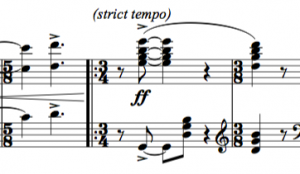
A few months ago, a student interviewed me for her research into the live/recorded music debate for ballet classes and examinations. In the middle of the interview, we got onto the subject of how different things were back in the 80s when I trained as a ballet pianist at the Royal Academy of Dance. There were 6 (possibly 7?) pianists, and wall-to-wall classes from morning til night, six days a week, so we got to know each others’ styles and mannerisms very well. It got to the stage where one pianist could do a brilliant imitation of another pianist imitating another pianist. We lived in a small room next door to the library on the 1st floor that had a squeaky door hinge. You could tell who was coming in by the way they opened the door.
I can’t remember which part of the picture I painted that surprised the student, but as we were talking, I remembered that I’d written this piece about the pianists there, back in 1986. It was inspired by Poulenc’s Les Soirées de Nazelles, a suite that for a while back then was my whole musical life. Poulenc’s piece was a set of light-hearted, dance-like miniatures that were warm, witty musical portraits of guests that started out as improvisations. At the time, I’d been in bed for a week with flu, and my brain was fried from trying to make musical sense of this strange ballet world that I’d fallen into, and I wrote the piece as a means of passing the time and getting it all out of my system as my flu got better, while Poulenc’s music swum around my head.
Although Les très riches heures de l’Académie Réal (as I called my piece) is nothing special as music, and makes more sense as something to look at than to hear, it’s interesting as a reminder of all kinds of things I’d forgotten – like the fact that classes all began at 9.15; of a tune that one of the pianists used to play for pliés that I’ve quoted somewhere at the bottom of page 2; that Ann Hogben used to eat Crackawheat for lunch. I’d forgotten how sick I’d become of particular ‘ballet cadences’ that were doing the rounds at the time, and of the dreadful things we’d do to waltzes in grand allegro to try to accommodate unmusical jumps. Nobody plays like that anymore. And I’d completely forgotten about my boss and his motorbike whose retreating sounds, as the piece suggests, punctuated the end of every day. In these respects, you could call the piece a contribution to sensory history, something that captures a sound-world of the time.
There is a whole tale to be told from the little asides in (probably not very good) French à la Satie, but I feel that would be telling. If you were there at the time, you’ll probably know exactly what they all mean. And if you really want to hear it as well, click below.
Click here for a free download of the piano score of Les très riches heures

